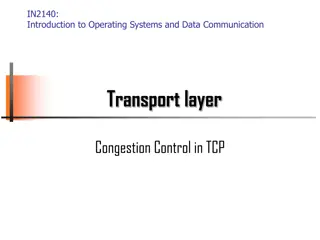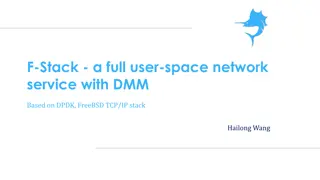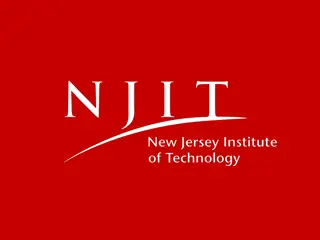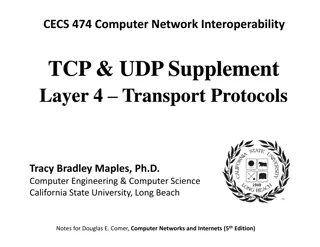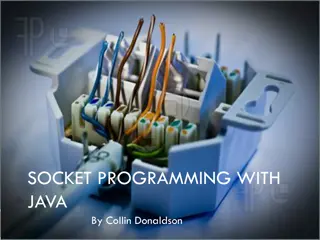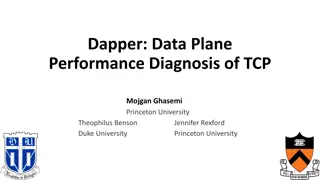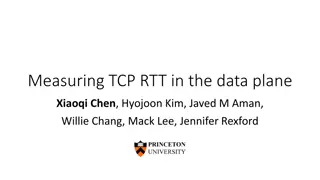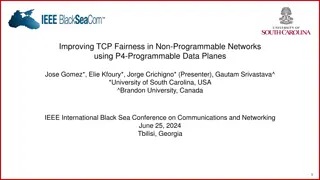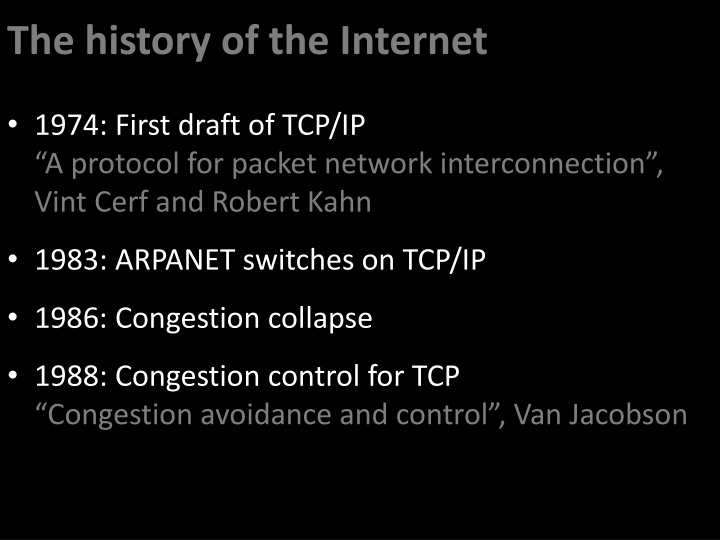
Evolution of Internet Protocols and Congestion Control Mechanisms
Explore the historical development of the Internet protocols TCP/IP by Vint Cerf and Robert Kahn, the ARPANET switch to TCP/IP, and the challenges faced with congestion collapse in the network. Learn about the innovative solutions such as congestion avoidance and control proposed by Van Jacobson. Dive into the intricacies of windowed flow control in data transmission and how TCP detects drops to ensure smooth communication. Understand the concept of congestion collapse where network responses to congestion result in wasted efforts.
Uploaded on | 0 Views
Download Presentation

Please find below an Image/Link to download the presentation.
The content on the website is provided AS IS for your information and personal use only. It may not be sold, licensed, or shared on other websites without obtaining consent from the author. If you encounter any issues during the download, it is possible that the publisher has removed the file from their server.
You are allowed to download the files provided on this website for personal or commercial use, subject to the condition that they are used lawfully. All files are the property of their respective owners.
The content on the website is provided AS IS for your information and personal use only. It may not be sold, licensed, or shared on other websites without obtaining consent from the author.
E N D
Presentation Transcript
The history of the Internet 1974: First draft of TCP/IP A protocol for packet network interconnection , Vint Cerf and Robert Kahn 1983: ARPANET switches on TCP/IP 1986: Congestion collapse 1988: Congestion control for TCP Congestion avoidance and control , Van Jacobson
In October of 86, the Internet had the first of what became a series of congestion collapses . During this period, the data throughput from LBL to UC Berkeley (sites separated by 400 yards and two IMP hops) dropped from 32 Kbps to 40 bps. We were fascinated by this sudden factor-of-thousand drop in bandwidth and embarked on an investigation of why things had gotten so bad. In particular, we wondered if the 4.3BSD (Berkeley UNIX) TCP was mis- behaving or if it could be tuned to work better under abysmal network conditions. Van Jacobson, Congestion avoidance and control , 1988
Windowed flow control acknowledgements Server (TCP) User data Suppose the sender has a certain number of tokens/permits. Each time he sends a packet he uses up a token; each time he receives an acknowledgement he regenerates one token.
A network control problem: how big a window should each source have? Maybe the receiver needs to receive data at some average rate xmin, to ensure smooth video playback. It could tell the sender Use w=xmin RTTtokens . The transmit rate is x=w/RTT. There could be centralized admission control, like the Erlang link issue new tokens only if the total traffic rate will not exceed the service rate. If the receiver has a buffer of 10 packets, it could tell the sender Start with 10 tokens; I ll issue you a new token whenever a packet is cleared from my buffer . This ensures that the receiver s buffer cannot overflow.
How TCP detects drops The sender puts a sequence number on each packet Server (TCP) 5 When the receiver receives a packet, it send back an ACK with the highest contiguous sequence number it has received User 2 3 1 4 * data acknowledgements If the sender receives duplicate ACKs, it knows that a packet was dropped (or that something was delivered out of order) 2 2 1 Server (TCP) User
Congestion collapse Server (TCP) User Server (TCP) User is when the system s response to congestion ends up causing effort to be wasted
Congestion collapse Server (TCP) User Server (TCP) User is when the system s response to congestion ends up causing effort to be wasted
To avoid congestion collapse, can we design clever end-systems that reduce their window sizes when they detect congestion in the network?
Jacobsons algorithm * * *
if (seqno > _last_acked) { if (!_in_fast_recovery) { _last_acked = seqno; _dupacks = 0; inflate_window(); send_packets(now); _last_sent_time = now; return; } if (seqno < _recover) { uint32_t new_data = seqno - _last_acked; _last_acked = seqno; if (new_data < _cwnd) _cwnd -= new_data; else _cwnd=0; _cwnd += _mss; retransmit_packet(now); send_packets(now); return; } uint32_t flightsize = _highest_sent - seqno; _cwnd = min(_ssthresh, flightsize + _mss); _last_acked = seqno; _dupacks = 0; _in_fast_recovery = false; send_packets(now); return; } if (_in_fast_recovery) { _cwnd += _mss; send_packets(now); return; } _dupacks++; if (_dupacks!=3) { send_packets(now); return; } _ssthresh = max(_cwnd/2, (uint32_t)(2 * _mss)); retransmit_packet(now); _cwnd = _ssthresh + 3 * _mss; _in_fast_recovery = true; _recover = _highest_sent; } transmission rate [0 100 kB/sec] time [0 8 sec]
* * * Each user increases his/her transmission rate when the network seems underused, and cuts it when one of his/her packets is dropped. * * * * * * * * * * * * * * * If all users do this, the network should end up near- 100% used, and the capacity should be shared fairly. The Internet is the first large-scale network to be able to regulate itself to share capacity fairly without a central controller.
+ + = + + = individual flow rates aggregate flow rate time





